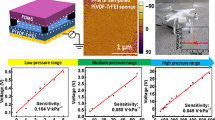Abstract
Ferroelectrets are used in capacitive piezoelectric sensors. When a force is applied to such a sensor, an electrical signal is generated. We first describe the equivalent circuit representation of a ferroelectret sensor element and proceed with the coupling of the sensor element to a measurement device. Based on the governing equations for the measurement signal following a given time-dependent force, we show that the sensors measure either force or force rate. We illustrate the use of ferroelectrets by proposing a reaction game using ferroelectret sensor elements. Several sensor elements are coupled to a measurement instrument, such as an oscilloscope, while forces are applied by the gamers as fast as possible with their hands. The sensor element is easily prepared by students within a few minutes, immediately enabling playing with the elements, followed by a fundamental understanding of ferroelectret force sensing.
Similar content being viewed by others
References
Bauer S (2006) Pyro-, piezo- and ferroelectrets: soft transducer materials for electromechanical energy conversion. IEEE Trans Dielectr Electr Insul 13:953–962
Bauer S, Gerhard-Multhaupt R, Sessler GM (2004) Ferroelectrets: soft electroactive foams for transducers. Phys Today 57:37–43
Dansachmüller M, Schwödiauer R, Bauer-Gogonea S, Bauer S, Paajanen M, Raukola J (2005) Elastic and electromechanical properties of polypropylene foam ferroelectrets. Appl Phys Lett 86:031910
EMFIT Homepage (manufacturer of ferroelectret foils and sensors) (2015) http://shop-eu.emfit.com/collections/sensors-ferroelectret-films. Accessed on 26 Nov 2015
Gerhard-Multhaupt R (2002) Less can be more: holes in polymers lead to a new paradigm of piezoelectric materials for electret transducers. IEEE Trans Dielectr Electr Insul 9:850–859
Neugschandtner GS, Schwödiauer R, Bauer-Gogonea S, Bauer S, Paajanen M, Lekkala J (2001) Piezo- and pyroelectricity of a polymer-foam space-charge electret. J Appl Phys 89:4503–4511
Neugschwandtner GS, Schwödiauer R, Vieytes M, Bauer-Gogonea S, Bauer S, Hillenbrand J, Kressmann R, Sessler GM, Paajanen M, Lekkala J (2000) Large and broadband piezoelectricity in smart polymer-foam space-charge electrets. Appl Phys Lett 77:3827–3829
Paajanen M, Lekkala J, Kirjavainen K (2000) ElectroMechanical Film EMFi – a new multipurpose electret material. Sensors Actuators 84:95–102
Sessler GM, Hillenbrand J (1999) Electromechanical response of cellular electret films. Appl Phys Lett 75:3405–3407
Sirohi J, Chopra I (2000) Fundamental understanding of piezoelectric strain sensors. J Intell Mater Syst Struct 11:246–256
Acknowledgments
Work partially supported by the Austrian Science Funds and by the European Research Council (Advanced Investigators Grant SoftMap).
Author information
Authors and Affiliations
Corresponding author
Editor information
Editors and Affiliations
Rights and permissions
Copyright information
© 2016 Springer International Publishing Switzerland
About this entry
Cite this entry
Bauer-Gogonea, S., Bauer, S., Baumgartner, R., Kogler, A., Krause, M., Schwödiauer, R. (2016). Polymer Electrets and Ferroelectrets as EAPs: How to Start Experimenting with Them. In: Carpi, F. (eds) Electromechanically Active Polymers. Polymers and Polymeric Composites: A Reference Series. Springer, Cham. https://doi.org/10.1007/978-3-319-31767-0_29-1
Download citation
DOI: https://doi.org/10.1007/978-3-319-31767-0_29-1
Received:
Accepted:
Published:
Publisher Name: Springer, Cham
Online ISBN: 978-3-319-31767-0
eBook Packages: Springer Reference Chemistry and Mat. ScienceReference Module Physical and Materials ScienceReference Module Chemistry, Materials and Physics



